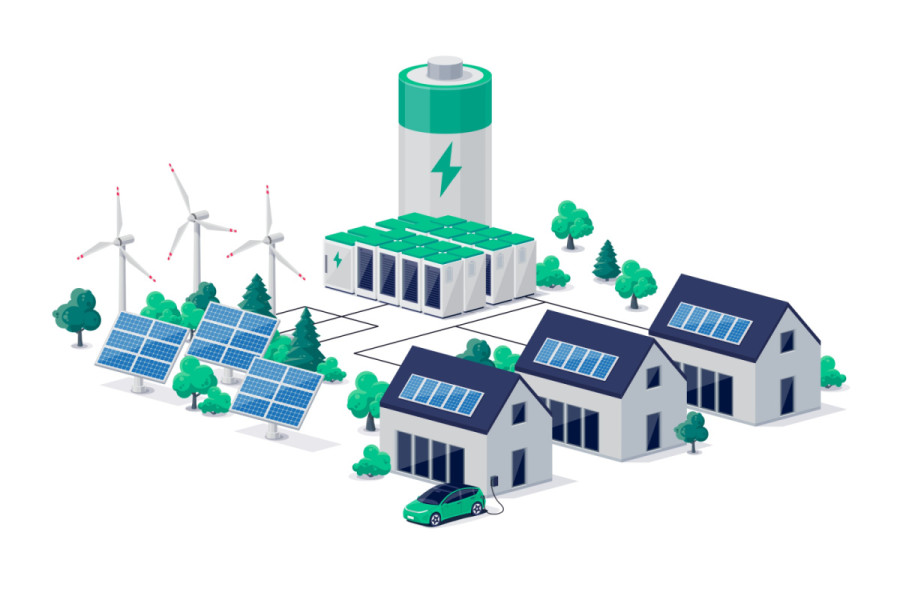Columns
Time to invest in virtual power plants
As the world shifts to renewables, effectively maintaining grid stability will be of utmost priority.
Aashish Chalise
When we think of power plants, the picture that comes to mind is a large, centralised infrastructure far away from load centres like cities and industries, with long transmission and distribution lines running across the country. A virtual power plant (VPP), however, could be a combination of distributed and centralised generators. Sunrun—a company in the United States which focuses on residential solar and storage systems—completed its first season of operating a residential VPP that competed in a wholesale capacity market in New England (a region consisting of six different states in the Northeast US). Sunrun’s VPP in New England is the first in the United States market, encouraging other states like Texas to pilot the technology. The New England VPP has a peak capacity of 20 megawatts generated from a combination of rooftop solar (RTS) and battery energy storage systems (BESS). Sunrun VPP is an aggregation of approximately 5,000 small RTS and BESS placed on residential rooftops. The VPP helped the New England power grid meet high demand during the summer heat. It also provided ancillary services, helped the grid manager shift load to manage peak demand, and supported demand response.
Variable renewable energy (VRE) sources such as solar, wind or hydro (run of the river) come with an inherent challenge of consistent and reliable energy supply. These technologies are weather and nature dependent. However, a battery energy storage system can solve this issue by storing and exporting electricity as required to meet demand, provide ancillary services, or provide reliable backup electricity for households and businesses. This combination of VRE and BESS integrated with smart technology (VPP) can aggregate and automate electricity from/to thousands of households or businesses. Reliable backup electricity provided by such a combination has been a lifeline for many cities around the world, including Kathmandu. During the time the city faced load shedding for up to 18 hours a day, it provided the basic electricity required to run households and businesses.
Kathmandu has immense potential to operate residential virtual power plants as successfully operated by Sunrun. The city has over 600,000 rooftops as per the national census of 2011. The last 10 years have seen a dramatic population growth, with an estimated 1 million rooftops potentially producing up to 1.5 gigawatts of solar power through rooftop solar. Kathmandu’s electricity demand peaks during the morning, from 6am-9am, and in the evening, from 5pm-9pm. One-fourth of the country’s peak load is consumed by Kathmandu, which poses many challenges to the Nepal Electricity Authority (NEA)—a vertically integrated utility that manages electricity generation, transmission and distribution throughout the country. The authority projects Kathmandu’s peak load to rise to 3,100 megawatts in the next three decades. But the city’s electrical infrastructure can only manage 500 megawatts. To address the rising demand, the NEA must invest in multiple centralised generators and transmission lines or rely on imports. It is estimated to spend Rs50 billion in building transmission lines to cater to Kathmandu’s load. A virtual power plant can provide the much-needed peak management facility to the NEA, and a combination of rooftop solar and battery energy storage systems can enable load shifting from peak hours to non-peak hours as and when required in Kathmandu.
Virtual power plants are controlled by highly sophisticated software and can be managed remotely in synchronisation with the grid. They can enable peak load shifting for the NEA and provide other ancillary services. Instead of the NEA spending billions to manage peak load, VPPs could compete through a bidding process, play an active role like other centralised generators, and provide multi-faceted benefits to both the NEA and consumers of the VPPs. In addition, they can provide immense flexibility to grid operators required to manage congested large load centres like Kathmandu. The intelligence a VPP brings is far superior to existing centralised plants, with the ability to respond to demand, load shifting and provide ancillary services.
The NEA has big plans to export electricity to neighbouring countries, India and Bangladesh. It can export electricity to the Indian market through the Indian Energy Exchange (IEX) and long-term contracts. The IEX is a day-ahead market; the price of electricity fluctuates and is driven by demand. If the NEA can sell in the IEX during peak demand, it would get more favourable tariffs per kWh compared to selling at off-peak hours and multiply its revenue. The NEA does not have access to large stored electricity as there is only one hydropower plant with storage capability while some smaller hydro plants can only provide very short-term storage (peaking run of river). A virtual power plant can allow the NEA to shift load and sell in the IEX when the price is high. If 400 megawatts, Kathmandu’s recently recorded peak load, can be absorbed by such power plants, the NEA could sell the remaining kWh at the IEX when the price is the highest. With India increasing its share of renewables in the energy mix, flexible power sources (VPPs and other forms of storage) are critical for grid stability as well as price stability in the electricity market. Dirty generators (coal, natural gas) have played a major role in generating electricity and stabilising the grid for decades. As the world shifts to renewables, effectively maintaining grid stability will be of utmost priority, on demand, dispatchable electricity will be a very valuable commodity.
The NEA's strategy to promote virtual power plants (VPPs) should follow a three-pronged approach. In the first phase, VPPs can be implemented for intra-day peak power shifting and for providing other minor ancillary services in a ring-fenced approach. A few small-size VPPs could be piloted to test the technical feasibility of such smart systems and most importantly formulate/implement concrete policies around VPPs which will position such systems for success.
Recent policy failure of net metering has already put a dent in the distributed renewable energy (DRE) sector. In the second phase, VPPs could be implemented to increase the share of cheaper variable renewable energy (VREs) in the energy mix. The intermittent nature of VREs like solar, wind and hydro (run of the river) is hampering the transition to a clean energy system. VPPs will stabilise VREs and provide storage with the ability to dispatch electricity on demand. In the third phase, the NEA should focus on both the Indian and Nepali markets to support grid integration of maximum renewable energy.
In the long run, VPPs will help NEA to defer infrastructure costs in centralised assets. They will provide a more dynamic technology that provides multi-level services to the electric grid. A VPP does not have to be limited to an aggregation of rooftop solar (RTS) and battery energy storage systems (BESS). Any electricity generator, electric vehicles and even demand side management could be part of a VPP. Successful implementation of virtual power plants will depend on consistent policies which will allow them to compete financially against other generators. VPPs must be compensated fairly for the immense flexibility they provide to the electric grid management.




 5.44°C Kathmandu
5.44°C Kathmandu















